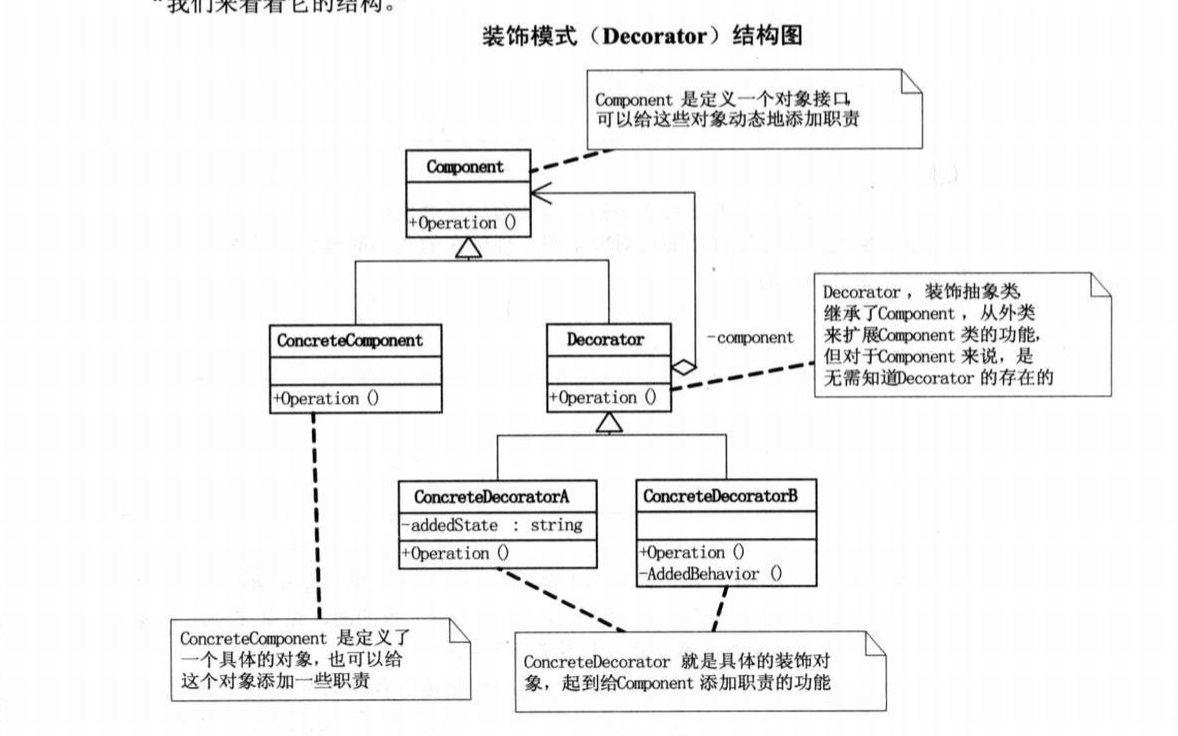UML代码结构图:


Clothes接口:
package com.sjmx.decorator.thrid; public interface Clothes { public void addClothes(); }
最简单的功能:
package com.sjmx.decorator.thrid; public class Person implements Clothes{ @Override public void addClothes() { System.out.println("java开始起床,先穿内裤"); } public void ak() { System.out.println("1"); } }
装饰抽象类 Decorator模拟:
package com.sjmx.decorator.thrid; public abstract class DecClothes implements Clothes { private Clothes clo ; public DecClothes(Clothes c) { this.clo = c; } @Override public void addClothes() { if(clo != null){ clo.addClothes(); } } }
Decorator的实现A:
package com.sjmx.decorator.thrid; public class PerClothA extends DecClothes { public PerClothA(Clothes c) { super(c); } @Override public void addClothes() { super.addClothes(); System.out.println("A开始穿裤子"); } }
Decorator的实现A:
package com.sjmx.decorator.thrid; public class PerClothB extends DecClothes { public PerClothB(Clothes c) { super(c); } @Override public void addClothes() { super.addClothes(); System.out.println("A开始穿外套"); } }
客户端代码:
package com.sjmx.decorator.thrid; public class Client { public static void main(String[] args) { Person p = new Person(); p.addClothes(); System.out.println("-----------------"); PerClothA a = new PerClothA(p); a.addClothes(); System.out.println("-----------------"); PerClothB b = new PerClothB(p); b.addClothes(); System.out.println("-----------------"); PerClothB c = new PerClothB(a); c.addClothes(); System.out.println("-----------------"); PerClothA d = new PerClothA(b); d.addClothes(); } }
运行结构:

总结:
1、从装饰模式的定义我们知道,装饰模式是动态的个对象添加额外的职责(功能)的。
2、为什么DecClothes抽象类要去实现Clothes接口,而后PerClothA、PerClothB再去继承DecClothes,而不是去直接实现接口?
答:a、抽象类可以让拥有的方法有一些默认的逻辑实现,而接口绝对不能有方法实现,这是DecClothes存在的原因之一;
b、 DecClothes抽象类实现了Clothes接口的addClothes()方法,同时有增持了Clothes类型的变量,这样的话,就可以确保无论DecClothes类有多少实现类,这些实现类同时也都是Clothes的实现类,这是多态决定的,这是原因二;
c、PerClothA、PerClothB、C、D、E、F、G等等,无论有多少个实现类,也无论是A包装B,还是B包装A,都可以实现,因为PerClothA、PerClothB、C、D、E、F、G都是Clothes的实现类,通过多态理解他们都是Clothes,而Clothes只是DecClothes的一个变量,而PerClothA、PerClothB、C、D、E、F、G又是DecClothes的实现类,那就保证PerClothA既是Clothes类型,又可以包含其他具体实现了DecClothes抽象类的子类,这是最重要的原因。(可能意会比言传要好一些)